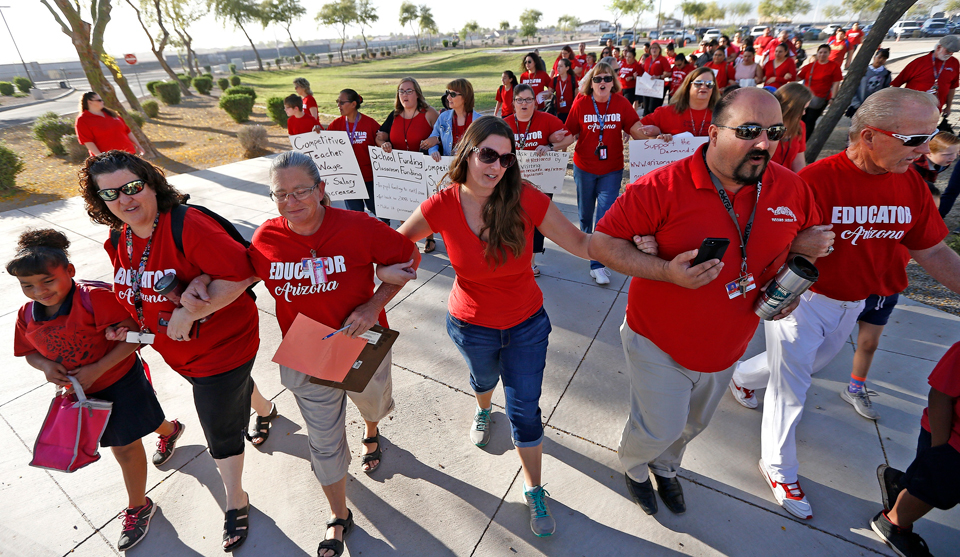
PHOENIX—Pushed to anger by a state school money offer both inadequate and unfunded, Arizona teachers took a strike authorization vote April 17-19, with ballots to be counted late in the evening of the 19th, the president of the state’s largest teachers union says.
And Joe Thomas, a government teacher at Skyline High School in Mesa, says they’re mad enough—and have drawn huge public support—to walk. That’s even though a 46-year-old ruling by the state attorney general’s office says the teachers, in a right-to-work state, can’t legally strike.
“I think we’re strong and ready to go,” Thomas, Arizona Education Association president, said in a telephone interview with People’s World. “We have school districts that are absolutely ready” to strike, including in Mesa (the state’s largest), the Phoenix high-school-only district, and Tucson.
Before that, community members, family members of Arizona students, and the teachers themselves staged a second “walk-in,” he explained. AEA didn’t organize the first protests. A seven-week-old grassroots citizens group, Arizona Education United, which now has 45,000 members, did. It was formed over social media. Now AEA is an enthusiastic partner with the citizens group.
With many of the teachers and their supporters wearing red T-shirts emblazoned with “#RedForEd” across the chest, the teachers and their supporters gathered along highways and at school campuses statewide on April 18 to support their quest.
Three minutes before schools were scheduled to start that morning, they all linked arms and walked in, en masse.
That protest was the latest in a series that saw 6,000 teachers invade the state capitol building in Phoenix, demanding money to help pay for quality education for the Grand Canyon State’s kids. Besides raises for themselves and staffers, they want up-to-date textbooks and decent buildings. Right-wing GOP Gov. Doug Ducey scrambled to offer the teachers—and only the teachers—a 20 percent raise by 2020. It wasn’t enough.
The teachers demanded a 20 percent raise this year, which would bring Arizona out of its dead-last (51st) position among states in teachers’ pay. National Education Association rankings show Arizona’s average is $47,218 yearly. Arizona also is #4 in crowded classrooms, with 21.5 students per teacher, even including kindergarten, NEA’s data shows.
“It’s routine to have classes in the upper 30s or even 40,” Thomas adds.
The teachers and their allies also want the state to reverse its 23 percent cut in school spending since 2008, including $100-$200 million lost to a 2014 GOP-implemented corporate tax cut alone. Total losses, Thomas calculates, are at least half a billion dollars.
The situation is so bad that 150,000 Arizona students—one in every seven—sit in classrooms being taught by long-term substitutes or short-termers who could have as little qualifications as a high school diploma or a GED. More-qualified teachers, trained by the state’s 627 local school districts, have fled to neighboring states for higher pay, or taken other jobs.
Ducey’s raise would be 10 percent this year, and the rest by 2020. The teachers, Thomas said, quickly did the math on it, and came up short.
The GOP governor’s raise this year comes from short-term fixes—using the state’s Medicaid expansion fund, for example—and higher sales tax revenue garnered by a rise in the state minimum wage which the state legislature’s ruling Republicans opposed. Ducey also takes money from school arts programs and $1 million from educating the developmentally disabled, Thomas noted.
The other 10 percent is only a promise of future funding, which Thomas likens to a New Year’s Day vow. Further, none of the money would go to the other staffers. And textbooks are outdated. History textbooks often end with the first Bush administration, in 1992.
“We need competitive salaries” for the support staff, Thomas explains. “If you’re the librarian, you don’t get the raise” in the governor’s plan. “And if you’re a classified employee”—a category of support staffers—“you’re not even thought of.”
“So the teachers are really pissed. There’s the cafeteria worker, the bus driver, the counselor. They’re all doing their jobs so I can teach social studies. And I’m going to get a raise and they aren’t? Hell, no.”
Arizona teachers and staffers “already had horrible working conditions,” including schools with leaky ceilings and loose floor tiles, due to state underfunding of construction and repairs, too, Thomas said. Arizona provides schools with only 15 percent of their construction money; the rest comes from local bond issues.
So another demand of the teachers, staffers, and their allies is to repeal the corporate tax cuts the GOP-dominated Arizona legislature has approved for the last decade or more, and dedicate that new funding stream to the schools.
The Arizona teachers were inspired by the successful grass-roots-driven teachers strike in West Virginia last month. Arizona teachers and their supporters used social media to quickly form Arizona Education United.
Similar grassroots teachers movements have occurred in two other GOP-run right-to-work states where Republicans slashed school spending, Kentucky and Oklahoma. And in Kansas, the heavily Republican legislature, after years of right-wing GOP Gov. Sam Brownback’s tax cuts for the rich and businesses left huge deficits and little money for the schools, revolted. It repealed his moves, thanks to citizen pressure for more money for schools and roads, among other priorities.










